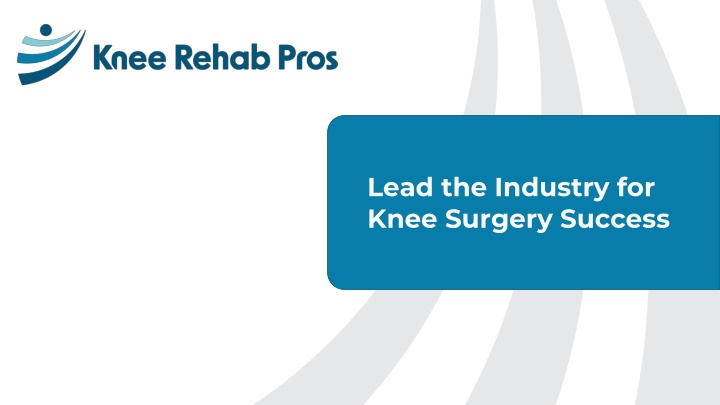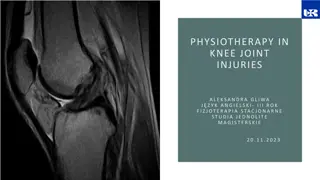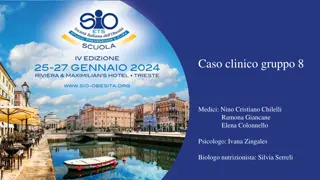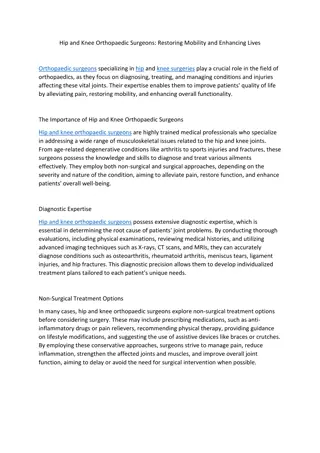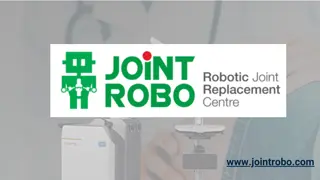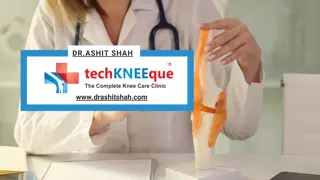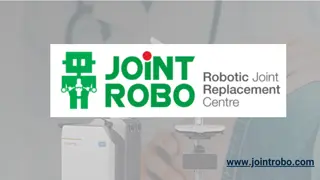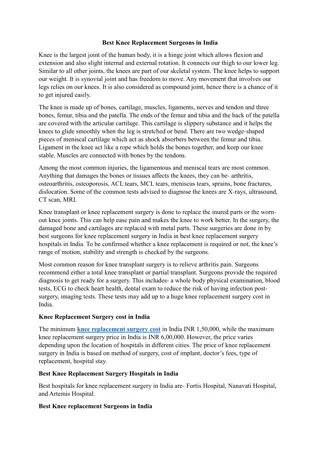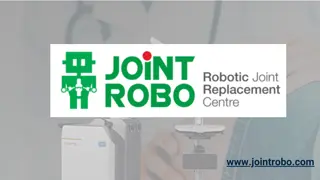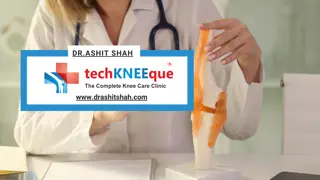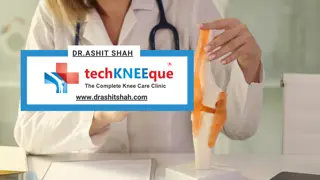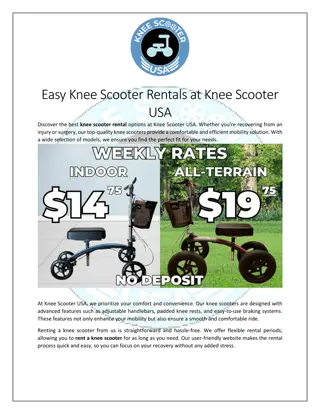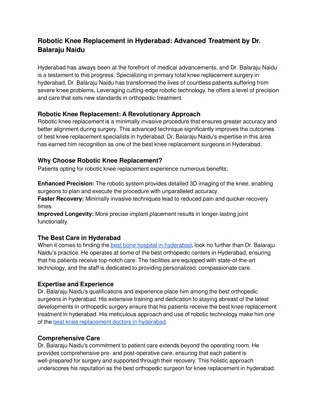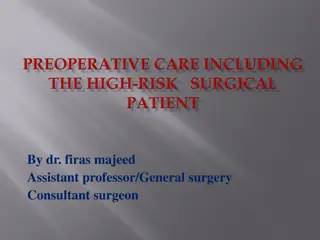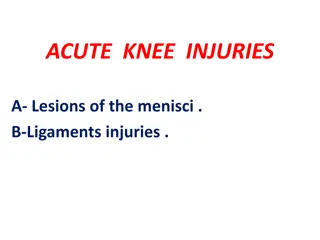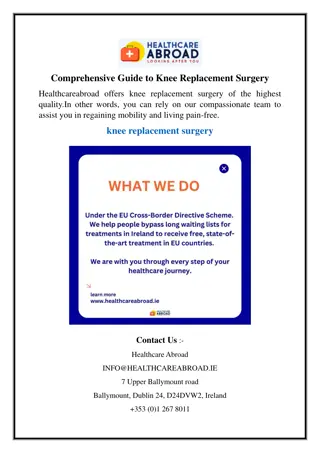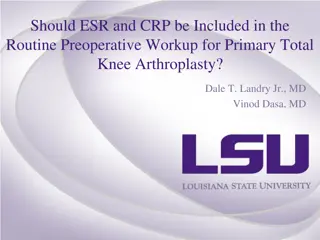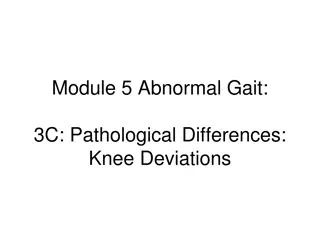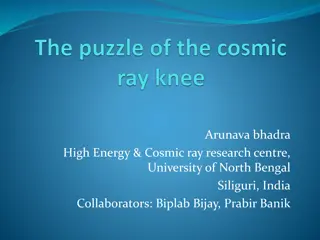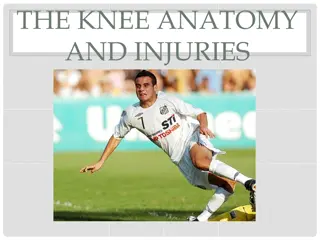Leading Knee Surgery Success: Elevate Patient Outcomes
Partner with Knee Rehab Pros to enhance knee surgery success through advanced care protocols. Discover the transformative RIET Protocol for optimal patient recovery post-knee surgery, preventing edema and maximizing function. Elevate your facility's reputation by prioritizing effective post-operative rehabilitation and achieving better patient outcomes.
Download Presentation

Please find below an Image/Link to download the presentation.
The content on the website is provided AS IS for your information and personal use only. It may not be sold, licensed, or shared on other websites without obtaining consent from the author.If you encounter any issues during the download, it is possible that the publisher has removed the file from their server.
You are allowed to download the files provided on this website for personal or commercial use, subject to the condition that they are used lawfully. All files are the property of their respective owners.
The content on the website is provided AS IS for your information and personal use only. It may not be sold, licensed, or shared on other websites without obtaining consent from the author.
E N D
Presentation Transcript
Lead the Industry for Knee Surgery Success
You got into orthopedic healthcare to raise the standard of care and help people reclaim the life they love. However, your attention spans a wide range of procedures, with your primary focus rightly on conducting successful surgeries. As your partner in patient care excellence, Knee Rehab Pros is focused on advancing your facility s standard of care specifically for Knee Surgeries.
Patient Outcomes = Facility Reputation It's not only about better patient outcomes; it's about elevating your hospital or surgery center s standard of care, and setting a new industry market. Afterall, every patient s success story is a testament to your hospital or surgery center excellence. (One of the best forms of advertisement!)
Most facilities are unknowingly missing the mark when it comes to early post-operative knee care Inconsistent post-operative rehabilitation instructions Your results reliant on the patient closely following the uncomfortable recovery recommendations at home Patients regain less than satisfactory function post-surgery: 24% fall within the first year 18% walk slower 51% have more difficulty climbing stairs 99% never regain optimal quadriceps strength, typically maxing out at a 20-25% deficit. Inability to descend stairs (100 ), lift grandchildren (117 ), garden (125 ), tie shoes (106 ) and other activities they need and love.
A Transformative Discovery After a combined 30+ years as an Orthopedic Surgeon and Knee Therapist, we discovered that a majority of knee surgery patients were not maximizing the small window of opportunity following surgery (1-2 weeks post-operation) to fully reclaim their function. With extensive research and testing, we discovered that if immediate post-operative care, and inpatient and outpatient rehabilitation prioritized preventing edema (swelling), patients could regain maximum range of motion (knee flexion and extension) resulting in dramatically better results. Swelling causes pain, stiffness, poor proprioception and a decrease in muscular contraction in the muscles surrounding the joint (Protective Shut Down) that prevents knee flexion and extension. If swelling is not prevented starting immediately after surgery, the ideal outcome is compromised.
Introducing RIET Protocol Edema control can give patients an advantage and a head start with rehabilitation. Edema control has been used for decades utilizing Rest, Ice, Compression, and Elevation (R.I.C. E.). Therefore, the best TKA protocol follows these principles: Elevation Therapy Rest Ice Limited activity Instead of being up in a chair and walking constantly, patients are up only for therapy sessions, bathroom breaks, and when doing exercises. In our setting this is achieved with a water circulating ice machine. And, there is a compression component when wrapping the ice pad around the knee.
PROOF IN THE NUMBERS: Initial Data Collection Data collection began in 2008 with TKA AAROM at hospital discharge. Initially we recorded knee extension (0-5 degrees) and knee flexion (> or = 90 degrees). No formal protocol utilized. Average Knee Flexion Full Knee Extension 90 Degrees or > Knee Flexion (0-5) Extension February 2008 N=9 44% 22% 0% 67 March 2008 N=15 53% 20% 47% 81 We discovered that only 33% of our patients were achieving full knee extension and our average knee flexion at hospital discharge was only 80 degrees. April 2008 N=27 81% 30% 30% 76 May 2008 N=22 84% 41% 23% 80 June 2008 N=17 94% 41% 29% 79 July 2008 N=15 87% 33% 13% 77 August 2008 N=19 79% 26% 32% 84 September 2008 N=10 60% 30% 20% 77 October 2008 N=8 100% 25% 38% 85 November 2008 N=24 75% 50% 50% 83 December 2008 N=19 79% 42% 47% 88 Average 76% 33% 28% 80
PROOF IN THE NUMBERS: RIET Protocol vs Standard Processes RIET Protocol N=39 Non Protocol N=24 First Qtr of 2009: The RIET Protocol was implemented for a portion of the patients of one surgeon. We recorded active assisted range of motion (AAROM) for all of the patients of this single surgeon and compared the use of the RIET protocol versus the traditional TKA rehab (non-protocol). The differences were significant. 0-5 Degrees Knee Extension 100% 46% 85 degrees or > Knee Flexion 87% 29%
PROOF IN THE NUMBERS: After Improved Education & Goals Flexion > or= 90 Degrees Average Knee Flexion (0-5 deg) Extension Full knee Extension In 2010 we were providing better education to all staff members and upgraded our objective goals. We believed that full knee extension was critical and started tracking this data. We also increased our knee flexion goal to 90 degrees or greater. We continued to see improvements. January 2010 N= 32 February 2010 N=38 March 2010 N=33 97% 72% 56% 90 95% 55% 66% 85 100% 67% 64% 89 April 2010 N=28 100% 75% 61% 94 May 2010 N=25 96% 67% 60% 91 June 2010 N=33 100% 76% 79% 92 July 2010 N=16 100% 56% 69% 90 August 2010 N=24 September 2010 N=32 October 2010 N=30 November 2010 N=43 December 2010 N=30 Average 96% 88% 67% 90 97% 81% 66% 91 100% 63% 60% 91 95% 56% 65% 86 93% 67% 70% 88 97% 69% 65% 90
A Hold Up The RIET Protocol was a clear success, but there was no good tool for comfortable, effective elevation - a critical step in RIET Protocol for preventing inflammation. The CPM, Boehler Pillow and foam blocks never kept the patient comfortably elevated in extension. They were okay for elevation, but patients were not getting their terminal extension back. And, they were reliant on families following very specific instructions during outpatient rehabilitation. We needed something more effective and reliable for patients to maximize range of motion.
Introducing The LRU Pillow The scientifically-designed LRU Pillow is proven to help a postoperative patients comfortably elevate their knee while holding it in terminal extension (keeping it as straight as possible) to mitigate swelling and maximize knee motion early. It is designed to be a user-friendly tool to make the the transition simple and increase adherence to the RIET Protocol: Elevation to achieve edema control Positioning to encourage knee extension while resting Light-weight Accommodate various patient sizes Allows for use in recliners, sofas, beds, etc. Capability of use during the entire recovery process. Implementing the RIET Protocol using the LRU Pillow at your hospital enables consistent, industry- leading results for your knee surgery patients. The LRU pillow must be placed under the patient's knee immediately following surgery and used throughout impatient and outpatient care for optimal recovery.
PROOF IN THE NUMBERS: LRU Pillow vs CPM In 2011 we examined the efficacy of using the CPM machine. We introduced an alternative elevation device that focused on knee extension at rest called the LRU pillow. We yielded better extension and flexion results when using the LRU pillow. CPM N=111 LRU Pillow N =131 0-5 Degrees Extension 87% 95% Flexion > or = 85 Degrees 67% 85% Flexion > or = 90 Degrees 60% 82%
PROOF IN THE NUMBERS: After RIET Protocol & LRU Pillow In 2010 we were providing better education to all staff members and upgraded our objective goals. We believed that full knee extension was critical and started tracking this data. We also increased our knee flexion goal to 90 degrees or greater. 0-5 Deg (Ext) Full Knee Ext. Flexion 90 deg. Or > Avg. Knee Flexion Avg. PT Tx's March 2012 N=4 April 2012 N=16 May 2012 N=14 June 2012 N=12 July 2012 N=13 August 2012 N=20 75% 75% 100% 114 3 94% 81% 94% 112 4 100% 64% 100% 110 4 We opened a new hospital in 2012 and began treating TKA patients in March. We were CPM-free, using the LRU pillow exclusively and were able to educate all staff members on the RIET protocol. By the end of 2012, 88% of our patients were achieving full knee extension at hospital discharge and our average knee flexion was 116 degrees. 100% 100% 100% 128 4 100% 85% 92% 111 4 100% 95% 100% 120 4 Sept. 2012 N=16 100% 94% 100% 115 4 October 2012 N=24 100% 92% 100% 114 4 November 2012 N=26 100% 100% 100% 118 3 December 2012 N=33 Average 100% 91% 100% 117 3 97 88 99 116 4
The Positive Trend Has Continued By the end of January 2024, 97% of patients achieve full knee extension at hospital discharge and the average knee flexion is 118 degrees due to the consistent implementation of RIET Protocol using the LRU pillow.
The Unparalleled Results Better pain control Minimal swelling Ability to more aggressively rehabilitate range of motion to a degree that allows them to do everything they enjoy (120 degrees) Time to regain strength and balance later (this window is not as small) Increase in practical function Faster and fuller recovery High praise for their surgeon and therapist
Achieving Early Knee ROM is the Tip of the Iceberg Early Range of Motion (ROM) is defined as ROM achieved in 1 to 2 weeks. This should be the focus of early post-operative care and rehabilitation. Controlling edema is critical. Once swelling begins it is challenging to reverse jeopardizing ROM. The RIET Protocol is an accelerated ROM program empowering patients to regain full range of motion during the short 1-2 week opportunity window following surgery. If we do not achieve early ROM that allows function, therapy cannot and should not move into the higher level rehabilitation. Once early ROM is achieved, then outpatient therapy can focus on Strength, Proprioception, Neuromuscular Re-education, Balance and Gait Quality, which do not have as small of a window.
Help Your Facility Set The Benchmark for Knee Surgery Outcomes Step 1 RECEIVE A FREE KNEE REHAB KIT Step 2 PURCHASE LRU PILLOWS FOR YOUR FACILITY & IMPLEMENT RIET PROTOCOL Step 3 LEAD THE INDUSTRY FOR KNEE SURGERY SUCCESS The educational materials, case studies, success metrics, and a complimentary LRU pillow provided in the Free Discovery Kit will empower you to effectively demonstrate its advantages to your orthopedic surgeon and purchaser. Like you, we are committed to the evolution of healthcare. Incorporating the LRU pillow into your patients' post-operative care will enhance their recovery experience and elevate your standard of care. This not only drastically improves the outcomes of your procedure, but also aligns your hospital or center with the highest industry standards. Purchase LRU Pillows for your facility to effectively implement the post-operative RIET Protocol. Send each patient home with this essential tool and a RIET Protocol Packet upon discharge to facilitate a seamless continuation of optimal rehabilitation at home.
